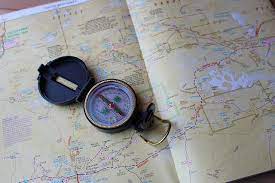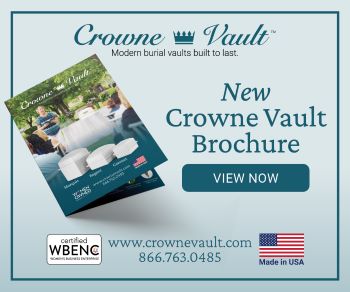Mapping Your Customer Journey: A Visual Tool for Deathcare Marketing

Editor’s Note: Today Welton Hong, CEO and founder of RingRing Marketing takes over the pen and gives us some valuable advice on Deathcare marketing. His article begins right here:
When was the last time you studied a map, planning out your route for a vacation or a trip to the ICCFA Convention? It’s probably been a while. Today, we can tap addresses into our phones or other GPS-enabled devices and get a digital route and map in return.

Welton Hong
Ring Ring Marketing
However, for the bulk of modern history, maps were critical tools for every journey. What started as visual guestimates became ever more accurate in detail as cartographers gathered data about the globe and gained mapmaking skills.
Before Ptolemy wrote On Geography around 150 CE, maps usually used visual scale to indicate the importance of a location—never mind the actual size of any city or nation. Ptolemy changed mapmaking history by creating ancient maps using mathematics, astronomy, and geography.
They weren’t extremely accurate, especially as they wandered far from the center of the known world at the time, because Ptolemy didn’t have access to all the necessary information. In fact, cartographers didn’t have enough data until the 18th and 19th centuries to draw the world as we know it today.
The global map may not be a huge concern for deathcare firms. But your customer journey map is important. Are you a Ptolemy, making decisions based on partial data, or are you a modern mapmaker, creating an accurate picture of your customer’s journey that supports good marketing decisions for your business?
What Is a Customer Journey Map?
This is a visual tool that illustrates your customer’s journey. It commonly takes the form of a flow chart, with various shapes depicting each stop and decision along the way. Customer journey maps can branch off into smaller quests as customers take different paths to conversion.
For example, one potential path for preplanning clientele for a funeral home might be:
- Someone discovers preplanning is an option, perhaps via social media posts or because someone they know is preplanning. They decide they want to know more.
- They search Google to find out more about preplanning and discover your website.
- After browsing your website, they decide to sign up for a preplanning webinar offered by your firm.
- After attending the webinar, they decide to purchase preplanning services from you.
A customer journey map outlines every possible path a consumer can take to becoming clientele. It captures all potential touchpoints and decision points to help you visualize how people become clientele so you can positively impact those paths to drive more yeses at ever decision point.
Benefits of a Customer Journey Map for Deathcare Marketing
A complete customer journey map provides numerous business and marketing benefits, including:
- Understanding the customer journey. Knowing how—and why—potential clientele connect with your firm can help you better serve them. How you work with someone who is in the early stages of a preplanning journey should look different from how you work with an at-need family—this is obvious. But how you market to and approach young preplanners who connected with you via social media may also be unique from how you market to older generations that connect via lunch-and-learn events you host. Taking time to map the customer journey helps you discover these details.
- Finding ways to improve the customer journey. When you map customer journeys visually, it’s easier to see potential pain points or missed connections. For example, you might realize you connect with many people on social media, but you don’t have a good bridge to bring those people from social media to your website or other conversion tools. If you don’t take time to build those bridges, the consumer’s journey with you ends at social media—they may take what they learn from you about deathcare and end up seeking services from another firm.
- Supporting holistic marketing approaches. A big-picture understanding of all the paths consumers can take to becoming your clientele helps you develop comprehensive marketing approaches. Holistic marketing lets you maximize returns on all channels and address your larger target audience—even if it’s composed of many unique segments.
How to Create a Customer Journey Map
To create a customer journey map, you can use post-it notes and a wall, a whiteboard, a spreadsheet, or flowchart software. Use the tools that work best for you and your team.
Start the process by listing your buyer personas. These are fictional characters that represent each of your target audience segments. You’ll need to complete the following steps for each buyer persona (or target audience segment):
- List all potential touchpoints a person might have with your firm or products.
- Identify the decision the person must make after each touchpoint (or the actions they might take). For example, one touchpoint might be a radio ad. The decision is whether the person ignores the ad for now or seeks further information.
- Create a flowchart that illustrates the relationship between the touchpoints and decisions.
- When you’re done, you should have a flow chart that shows all the ways a person can move from target audience member to potential clientele.
Create a customer journey map for each buyer persona if necessary. If your customer journeys aren’t especially complex, you may be able to show all customer journeys in one illustration.
Once you’re done with the flow chart, talk about it with your team. Analyze the visual information, asking questions such as:
- Is there anywhere in the journey the person can get stuck?
- Are any touchpoints missing strong connections that help move consumers to the next part of the journey?
- Are people saying “no” more often than “yes” at certain decision points, and how can you change that?
- What parts of the customer journey work best, and can you maximize them to support more conversions and revenue?
By asking these types of questions, you can find ways to improve deathcare marketing and drive more potential clientele to your firm.
Funeral Director Daily take: At Funeral Director Daily we are extremely proud to have among our sponsors Welton Hong and his team at RingRing Marketing. Welton and his team have proven that by using RingRing’s philosophy of marketing that they can make your funeral home phone ring as they have done for over 600 other funeral homes.
To learn more about Welton Hong and his team at RingRing Marketing click here.
More news from the world of Death Care:
- Bodies, remains found in warehouse linked to illegal cremations company. Video news story and print article. KRON TV – San Francisco (CA)
- Jarden pops up in TPG Capital camp at InvoCare. Australian Financial Review
- Going Gently: Mortuary owner eases anxiety of planning funerals. The Argonaut (CA)
- New bill from local senator seeks to legalize water cremations in Texas. Dallas Observer (TX)
- Unclaimed remains in Marion County nearly double, part of growing issue. Video news story and print article. WTHR TV – Indianapolis (IN)
- Pure Cremation going the extra mile on a final journey whatever the weather. Respond Resource Press Release (Great Britain)
Enter your e-mail below to join the 3,182 others who receive Funeral Director Daily articles daily:
 





















